Removal
1. Position the motorcycle on its centrestand if fitted or on an auxiliary stand and support it so that the front wheel is off the ground. Always make sure the motorcycle Is property supported.
2. Displace the brake calipers (see Section 4). Support the calipers with a cable tie or a bungee cord so that no strain is placed on the hydraulic hoses. There is no need to disconnect the hoses from the calipers.
Note: Do not operate the front brake lever with the calipers removed.
3. Undo the screw securing the speedometer cable in the drive housing on the right-hand side of the wheel and detach the cable, noting how it locates (see illustration).
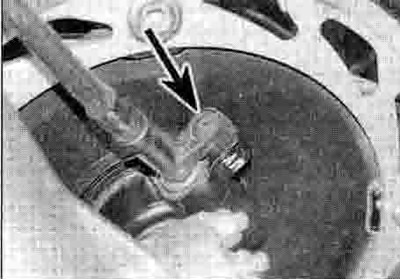
13.3. Undo the screw (arrowed) and detach the cable
4. Slacken the axle clamp nuts on the bottom of the right-hand fork, then unscrew the axle (see illustration).

13.4. Slacken the axle clamp nuts (A), then unscrew the axle (B)
5. Support the wheel, then withdraw the axle from the right-hand srde, using a drift to tap il out if necessary, and carefully lower the wheel (see illustration).

13.5. Withdraw the axle and remove the wheel
6. Remove the speedometer drive housing from the right-hand side of the wheel, noting how it fits, and the spacer from the left-hand side, noting which way round it fits (see illustrations).
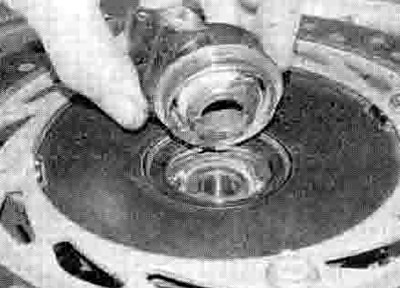
13.6a. Remove the speedometer drive housing...
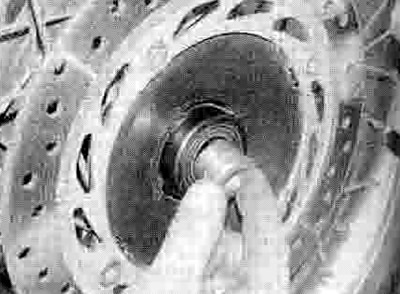
13.6b ...and the spacer
Caution: Don't lay the wheel down and allow it to rest on a disc - the disc could become warped. Set the wheel on wood blocks so the disc doesn't support the weight of the wheel.
7. Check the axle for straightness by rolling II on a flat surface such as a piece of plate glass (first wipe off all old grease and remove any corrosion using fine emery cloth). If the equipment is available, place the axle In V-blocks and measure the runout using a dial gauge. If the axle is bent or the runout exceeds the limit specified, replace it with a new one.
8. Check the condition of the grease seals and wheel bearings (see Section 15).
Installation
9. Apply a smear of grease to the inside of the speedometer drive housing and the wheel spacer, and also to the outside where they fit into the wheel. Fit the drive housing into the right-hand side of the wheel, locating its slots over the drive plate tabs, and the spacer Into Ihe left-hand side, with its shouldered end lacing out (see illustrations 13.6a and b).
10. Manoeuvre the wheel into position between the fork sliders with the speedometer drive on the right-hand side. Apply a thin coat of grease to the axle.
11. Lift the wheel into place, making sure the drive housing and spacer remain in position. Slide the axle in from the right-hand side (see Illustration 13.5) and thread it into place. Rotate the speedometer drive housing so that its lug butts up against the back of the stopper on the front fork (see illustration), then tighten the axle to the torque setting specified at the beginning of the Chapter (see illustration). Check that the wheel spins freely.

13.11a. Butt the speedometer drive housing against the back of the lug (arrowed)

13.11b. Tighten the axle to the specified torque
12. Lower the front wheel to the ground, then Install the brake calipers (see Section 4).
13. Apply the front brake a few times to bring the pads back into contact with the discs. Move the motorcycle off its stand, apply the front brake and pump the front forks a few times to settle all components in position.
14. Now tighten the axle clamp nuts on the bottom of the right-hand fork to the specified torque setting, tightening the upper ones first, then the lower ones (see illustration 13.4). Note that if the clamp face was removed it must be fitted with the UP mark pointing up (see Illustration).

13.14. Make sure the UP mark faces up
15. Fit the speedometer cable into the drive housing, making sure it engages correctly, and secure it with its screw (see illustrations).
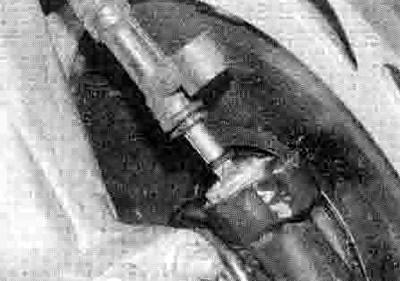
13.15a. Make sure the drive tab locates in the slot in the cable end...
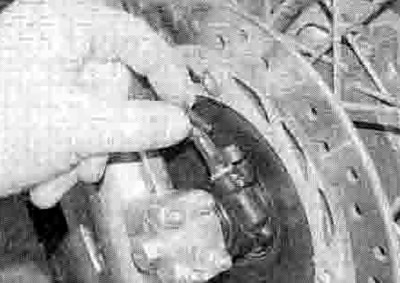
13.15b ...then secure the cable with the screw
16. Check for correct operation of the brakes before riding the motorcycle.
